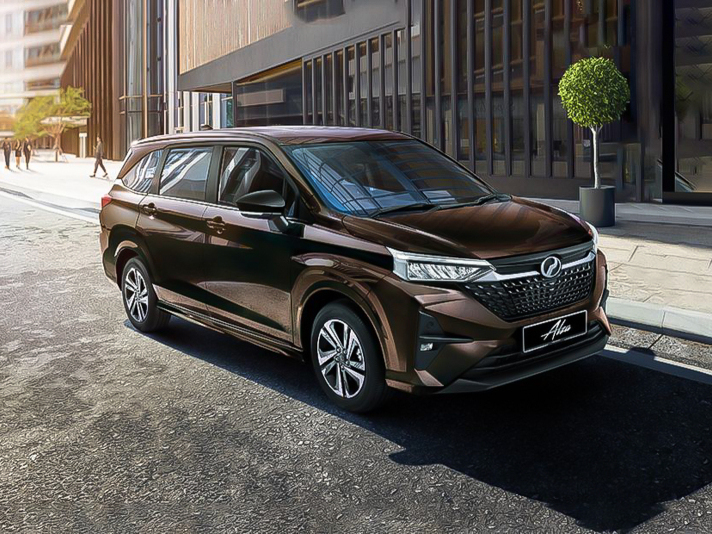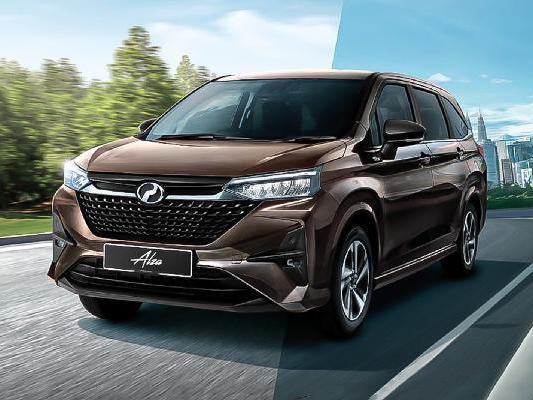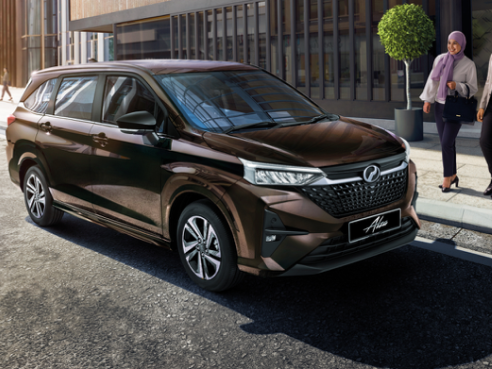Q
perodua alza berapa seater
The BYD Atto 3 is a compact all-electric SUV from Chinese automaker BYD that's been turning heads in the Malaysian market. Positioned as a global EV offering, it blends modern design, cutting-edge tech, and everyday practicality. Built on BYD's e-platform 3.0, the Atto 3 packs an efficient electric drivetrain that delivers impressive range – official figures tip it over 400 km (though your real-world mileage may vary depending on driving conditions), making it a solid fit for Malaysian city commutes and short getaways.
Step inside, and you'll find BYD's signature rotating infotainment touchscreen, a smart connected system, and a decent suite of safety kit like adaptive cruise control and lane-keeping assist, all of which up the ante in terms of driver convenience and peace of mind. Beyond the tech, the Atto 3 sports a youthful, dynamic design, and the interior makes use of eco-friendly materials, aligning with modern buyers' growing focus on sustainable mobility.
For Malaysian consumers, the Atto 3 isn't just about going green – it also makes financial sense. Ditching petrol costs and road tax, plus tapping into government incentives for EVs, makes this a pretty compelling value proposition. As Malaysia's EV infrastructure continues to roll out and improve, models like the BYD Atto 3 are poised to become go-to choices for more families and individuals alike.
Special Disclaimer: This content is published by users and does not represent the views or position of PCauto.
Related Q&A
Q
What was the fuel economy of Alza 2018?
The 2018 Alza delivers average fuel economy. Its 1.5-liter naturally aspirated engine paired with a 4-speed automatic transmission returns a combined fuel consumption of approximately 6.5 to 7.0 liters per 100 kilometers. Actual figures may vary depending on driving habits, road conditions, and vehicle maintenance. As a family MPV, its fuel efficiency is par for the course in its class, making it suitable for daily commuting and family use.
If owners want to improve fuel efficiency, they can maintain a steady driving speed, avoid sudden acceleration and hard braking, and regularly replace engine oil and air filters. These simple tips not only help save fuel but also extend engine life.
Additionally, with advancements in automotive technology, hybrid and fully electric models have seen significant improvements in fuel economy in recent years. If fuel consumption is a top priority, these new-technology vehicles are worth considering. However, as an affordable and practical option, the Alza still meets the daily needs of most families.
Q
What are the dimensions of the Alza 2018?
The 2018 Alza measures 4270mm in length, 1695mm in width, and 1600mm in height, with a wheelbase of 2750mm. As a compact MPV, these dimensions offer nimble handling for city driving while ensuring practical interior space, making it ideal for family use. It has a ground clearance of 160mm, which can handle regular road conditions, and a 42-liter fuel tank that meets the needs of daily commuting and short to medium-distance trips. For some extra context, the 2018 Alza uses a front-engine, front-wheel-drive layout. This design helps maximize interior space, especially when it comes to arranging the second and third-row seats. While the third row is more suited for kids or short rides, the overall space performance is still competitive in its class. Additionally, it weighs around 1.2 tons and is paired with a 1.5-liter naturally aspirated engine, striking a good balance between fuel efficiency and power output – perfect for consumers who value practicality and economy.
Q
How many seats does the Alza 2018 have?
The 2018 Alza is a 7-seater compact MPV with a 2+3+2 three-row seating configuration, ideal for families or group outings. The second-row seats slide forward and backward to boost flexibility, while the third row is best suited for kids or short trips. It’s pretty good at space utilization – there’s still basic storage in the trunk when the third row is upright, and folding it down expands cargo capacity even more. The 2018 Alza comes with a 1.5L naturally aspirated engine paired with a 4-speed automatic transmission, focusing on affordability and practicality, with fuel economy that fits daily commuting needs. Among its peers, the seat functions lean into utility – like the split-folding second row, which makes loading longer items easier. Just keep in mind, legroom in the third row might feel a bit tight for adults, so a test drive is recommended. These compact MPVs are popular in the local market because they blend car-like driving feel with the ability to carry multiple people, perfect for budget-conscious buyers who need a 7-seater.
Q
What colors did the Alza 2018 come in?
The 2018 Alza comes with a variety of color options, including Pearl White, Metallic Silver, Metallic Gray, Metallic Black, and Red. These colors are not only classic and timeless but also cater to different consumers' personalized needs. Pearl White and Metallic Silver are the more popular choices because they hide dirt well and are easy to maintain, making them perfect for daily use. On the other hand, Metallic Black and Red give off a sportier vibe, ideal for owners who want a stylish look. Beyond just aesthetics, color choice can also affect a car's resale value. Generally, neutral colors like white and silver are more sought-after in the used car market and tend to hold their value better. Additionally, different colored paints have slight differences in maintenance. Dark-colored paints show scratches more easily and require more frequent waxing and care, while light-colored paints are relatively low-maintenance. If you're considering buying this car, you can choose the right color based on your personal preference and actual usage needs. Also, remember to regularly maintain the paint to keep the car in good condition.
Q
What changes were made to Alza in 2018?
The 2018 Alza gets minor upgrades focused on styling and features. The front end gets a sleeker chrome grille, and new LED daytime running lights boost visibility. Some higher trims also score fresh alloy wheel designs. Inside, the practical layout stays, but seat materials are updated and storage spaces are tweaked. Certain versions add a multifunction steering wheel and an upgraded sound system. Under the hood, it still runs the 1.5L naturally aspirated engine paired with a 4AT gearbox, but the tuning improves low-speed smoothness. Safety-wise, dual airbags and ABS+EBD come standard across the range, while the top trim adds a reverse camera. Notably, this refresh focused on better sound insulation materials, which does a better job of keeping wind noise in check at highway speeds. For used car shoppers, the 2018 model holds strong value on the used market thanks to its reliable reputation and low maintenance costs. Just make sure to check the transmission condition closely—it's the component that tends to need the most attention in this lineup.
Q
What engine options were available in Alza 2018?
The 2018 Alza comes with two engine options: a 1.5-liter 4-cylinder naturally aspirated engine (code 3SZ-VE) and a 1.5-liter 4-cylinder naturally aspirated Dual VVT-i engine (code 1NZ-FE), both known for their reliability and fuel efficiency. The 3SZ-VE engine puts out 104 horsepower and 136 Nm of peak torque, while the 1NZ-FE is slightly more powerful with 107 horsepower and 141 Nm of peak torque. Both are paired with a 4-speed automatic transmission, which works well for city driving. As a family MPV, the Alza's engines prioritize smoothness and durability, making it ideal for daily family use. It also has relatively low maintenance costs and is easy to repair. If you're after more power, keep an eye on newer models—these days, a lot of brands are adding turbocharging or hybrid tech to boost performance and fuel efficiency. But the 2018 Alza still focuses on practicality and affordability, perfect for budget-conscious buyers who value usefulness.
Q
Does the Alza 2018 have good reviews?
The 2018 Alza, as a practical and budget-friendly MPV, generally gets positive reviews, especially suited for family users. Its strengths lie in good space flexibility and fuel efficiency. While the third-row seats are a bit tight, they're acceptable for short trips. The 1.5L engine paired with a 4AT transmission is a mature powertrain with low maintenance costs. The interior focuses on functionality, with materials that meet expectations for its price range. However, in terms of features, it might feel a bit basic compared to competitors from the same era, lacking some modern tech gadgets. The suspension is tuned for comfort, ideal for city driving, but there's noticeable body roll when cornering at higher speeds. It holds its value moderately well in the used car market. As a family runabout, this car checks the boxes, but if you're after better driving dynamics or more tech, you might want to look elsewhere. Potential buyers should definitely test drive it to see if the space and handling fit their needs.
Q
Where was the Alza 2018 manufactured?
The 2018 Alza rolled off the production line at the Karawang plant in Indonesia. As a practical and budget-friendly MPV, it’s won over plenty of family buyers with its flexible interior layout and reliable performance. The main reason it’s built in Indonesia? The region’s well-established manufacturing system and supply chain advantages, which let it meet the needs of Southeast Asian markets. It’s worth mentioning that the 1.5-liter engine under the hood strikes a nice balance between fuel efficiency and power. Plus, with its 7-seat setup, it’s perfect for daily family use or small group getaways. In local markets, its relatively low maintenance costs and ample parts supply further boost its value for money. For consumers considering a used car, the 2018 Alza remains a solid choice—its durability and practicality have stood the test of time, making it capable of meeting most families’ travel needs.
Q
What is the fuel consumption of Alza 2018?
Based on official figures and owner feedback, the 2018 Alza's fuel economy for the 1.5L automatic variant sits around 6.5 to 7.2 liters per 100 kilometers combined. Your actual numbers will vary depending on driving habits, road conditions, and how well you maintain the vehicle – the manual transmission version might be slightly more efficient. Power comes from a 1.5L DVVT naturally aspirated engine paired with either a 4-speed auto or 5-speed manual gearbox. Fuel efficiency is right in the mainstream for its class of MPVs, making it a solid pick for family daily use. To squeeze out better mileage, keep up with regular air filter and spark plug maintenance, check tire pressures often, and avoid sudden acceleration or hard braking. It's also worth noting that MPVs, with their heavier bodies and higher wind resistance, typically drink a bit more fuel than sedans with the same engine size – that's just the nature of the beast. When choosing, you've gotta balance interior practicality against fuel costs.
Q
What is the price of Toyota Zenix 2023?
The 2023 Toyota Zenix is priced between approximately RM 140,000 and RM 170,000 in the Malaysian market, depending on the variant and specifications. Actual prices may vary slightly based on regional dealer promotions or optional extras. Positioned as Toyota's versatile family MPV, the Zenix comes with either a 2.0-liter naturally aspirated engine or a 1.8-liter hybrid powertrain, striking a balance between fuel efficiency and performance. Inside, you'll find a large touchscreen display, smart connectivity features, and Toyota's latest TSS safety suite—all tailored to meet family needs.
It's worth noting that Malaysian MPV buyers typically cross-shop rivals like the Honda BR-V or Mitsubishi Xpander. However, the Zenix holds its own in this segment, leveraging Toyota's strong brand reputation and the added appeal of hybrid technology. If you're in the market, I'd recommend checking with authorized dealers for the latest quotes and promotional packages. Be sure to request a test drive too—you'll want to experience firsthand the hybrid system's smooth power delivery and quiet operation, trends that are quickly gaining traction in Malaysia's automotive landscape.
Popular Cars
Model Year
Car Compare
Car Photo
Latest Q&A
Q
What exactly is fuel?
Fuel refers to substances that can release their stored energy through chemical reactions (such as combustion) or nuclear reactions. It is widely used in scenarios like power generation, transportation, industrial production, and daily life, providing thermal energy, mechanical energy, or electrical energy support for various equipment and systems. Classified by physical state, fuel can be divided into three categories: solid (e.g., coal, wood, biomass fuel), liquid (e.g., gasoline, diesel, biodiesel), and gas (e.g., natural gas, hydrogen, liquefied petroleum gas); classified by source, it can be divided into fossil fuels (e.g., coal, oil, natural gas) and renewable fuels (e.g., biomass fuel, ethanol, etc.), in addition to nuclear fuels (e.g., uranium, plutonium) that can release nuclear energy. In the automotive field, gasoline and diesel are currently the most commonly used conventional fuels, suitable for spark-ignition and compression-ignition engines respectively; meanwhile, alternative fuels such as compressed natural gas (CNG), liquefied petroleum gas (LPG), biodiesel, and ethanol are gradually being applied in automotive power systems due to their advantages in environmental protection or renewability, to meet different energy needs and environmental requirements.
Q
What is gas vs petrol?
Actually, gas (short for gasoline in American English) and petrol (a term used in British English) essentially refer to the same fuel—gasoline. Both are flammable liquids refined from crude oil and used in spark-ignition internal combustion engines. They share identical core components and functions, differing only in terminology due to regional linguistic conventions.
In the local market, the primary gasoline variants are RON95 and RON97. RON95, being more affordable due to government subsidies, serves as the recommended fuel for most vehicle models (such as the Jaecoo J7 SUV). The 1.6TGDI turbocharged engine equipped in these models is specifically calibrated to leverage RON95's anti-knock properties, delivering 156 horsepower while optimizing fuel efficiency—making it ideal for local hilly terrains and congested urban roads. RON97, with its higher octane rating, offers superior anti-knock performance but at a comparatively elevated cost.
Octane rating serves as the critical metric for evaluating gasoline's anti-knock capability. Vehicle owners should adhere to the engine compression ratio specified in their owner's manual when selecting the appropriate fuel grade, thereby preventing diminished engine performance or accelerated wear. Furthermore, local motorists should prioritize reputable gas stations to mitigate risks posed by substandard gasoline to the fuel system. The use of OEM-recommended fuel additives can also help maintain injector cleanliness, preserving both vehicle performance and longevity.
Q
What are the four types of fuel?
The four common types of fuel include solid fuels, liquid fuels, gaseous fuels, and nuclear fuels. Solid fuels such as coal and coke can release a large amount of thermal energy when burned, and are often used in thermal power generation or industrial heating scenarios; liquid fuels like gasoline and diesel, refined through petroleum processing, are the main power sources for transportation tools such as cars and trucks; gaseous fuels such as natural gas and liquefied petroleum gas (LPG) have a clean and efficient combustion process, and are widely used in household cooking, heating, and industrial production equipment; nuclear fuels like uranium-235 and plutonium-239 release energy through nuclear reactions, which is used in nuclear power generation, featuring high energy density and no direct greenhouse gas emissions. These fuels play key energy supply roles in different fields, meeting the diverse energy needs for power generation, transportation, industrial manufacturing, and daily life.
Q
Is fuel called gas?
In Malaysia, different types of fuels have different names. Gasoline (used in spark-ignition internal combustion engines such as passenger cars and motorcycles) is usually called "petrol" (in English) or "minyak petrol" (in Malay) instead of "gas"; while fuels like liquefied petroleum gas (LPG) are sometimes abbreviated as "gas". Common gasoline variants in Malaysia include RON95 and RON97. Among them, RON95 is more affordable due to government subsidies. In April 2024, the price of RON95 was approximately $0.43 per liter, and RON97 was about $0.73 per liter. Gasoline is produced through the fractional distillation of crude oil, with various additives added to enhance chemical stability, control corrosion, and clean the fuel system. Some gasoline also contains components such as ethanol to improve combustion efficiency.
Q
Is LPG a fuel gas?
Yes, liquefied petroleum gas (LPG) is a type of fuel gas. It is mainly composed of propane and butane, with some products containing small amounts of propylene and butylene. It is derived from the petroleum refining process or volatile gases from natural gas extraction. LPG is a gas at normal temperature and pressure, but can be liquefied into liquid form through pressurization or low-temperature treatment for easy storage and transportation, and is released as a gas when used. It has a wide range of uses, including as fuel for automobiles (especially suitable for light vehicles), domestic cooking fuel, industrial heating fuel, etc., and is also an important petrochemical raw material. Compared with traditional fuels, LPG has advantages such as less pollution (no dust residue after combustion), high calorific value (about twice that of coal per unit weight), convenient transportation, and stable supply pressure. However, due to its flammable nature, strict compliance with safety operation regulations is required during use to avoid safety risks caused by leakage.
View MoreRelated News

Perodua Alza Interior Design Revealed: Malaysia's Top Choice for Family MPV
AshleyJul 23, 2025

A Complete Guide to Perodua Alza: Must-Read Money-Saving Tips for Car Buyers
RobertMar 25, 2025

Perodua Alza: Priced from RM 62,500, the most cost-effective all-round MPV?
LienMay 31, 2024

Perodua Myvi and Bezza may undergo major upgrades in 2026
LienDec 24, 2025

Perodua Traz VS Ativa, which one is more worth buying?
AshleyDec 23, 2025
View More


















Pros
Cons